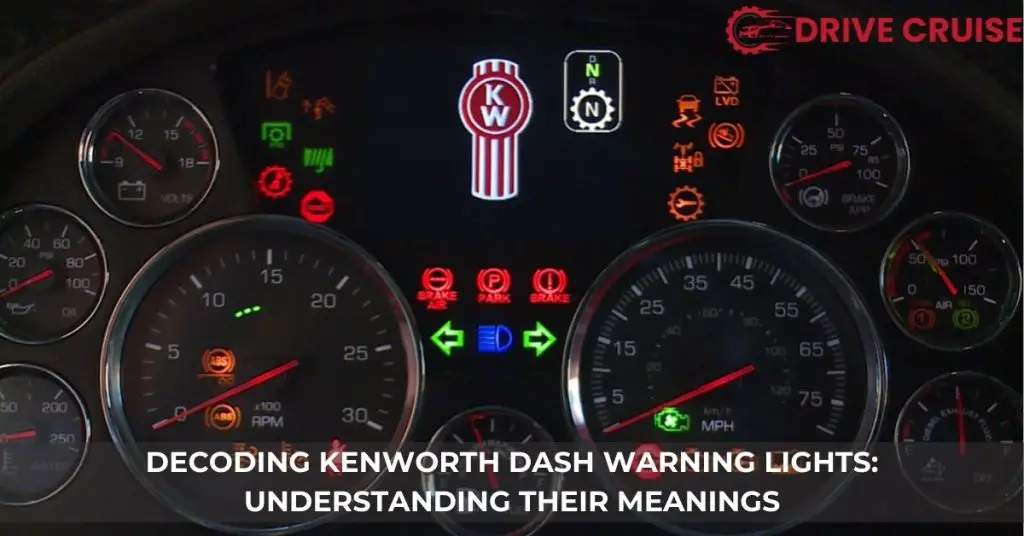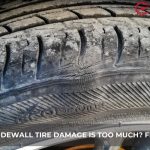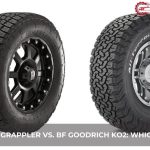We’ve all been there, cruising down the highway when suddenly a dash warning light flickers on. It’s easy to feel a mix of confusion and concern, especially if you’re behind the wheel of a Kenworth. These trucks are built tough, but like any vehicle, they communicate through their dash lights, warning us when something’s amiss.
Understanding what these lights mean isn’t just about peace of mind—it’s also crucial for maintaining the safety and longevity of your truck. Whether it’s a gentle reminder for maintenance or an urgent alert for immediate action, knowing the language of your Kenworth’s dash lights can save you time and money. So, let’s dive into the colorful world of dash warning lights and decode their messages together.
Understanding Kenworth Dash Warning Lights
Decoding the messages conveyed through Kenworth truck dash warning lights plays a pivotal role in ensuring the vehicle’s safety and longevity. Each light on the dashboard serves as a direct communication link between the truck’s various systems and the driver. Recognizing what these lights signify allows for timely maintenance, avoiding potential costly repairs and ensuring road safety.
- Engine Warning: This light indicates potential issues with the truck’s engine. When it lights up, it’s a signal that the engine needs checking. Ignoring it could lead to serious engine damage.
- Oil Pressure Warning: Low oil pressure is a critical concern, and this light warns the driver about it. Maintaining proper oil pressure is essential for the engine’s longevity, making it crucial to address this warning immediately.
- Battery Charge Warning: Should this light come on, it suggests there’s an issue with the truck’s electrical system. Possibly, the battery isn’t charging correctly, which could lead to problems starting the truck if not resolved swiftly.
- Brake System Warning: This light signals a possible malfunction within the brake system. Given the importance of brakes for safety, it’s imperative to have the system checked at the first sign of this warning light.
- ABS Warning Light: The Anti-lock Braking System (ABS) light indicates a problem with the truck’s ABS. While the truck can still brake, the ABS feature, which prevents wheel lockup during an emergency stop, might not function as intended.
By staying informed about these and other Kenworth dash warning lights, drivers can act promptly when they illuminate. Addressing these issues not only helps in maintaining the truck’s performance but also contributes significantly to road safety. Regular maintenance checks and being responsive to these dash warnings ensure that Kenworth trucks remain reliable companions on the road.
Common Kenworth Dash Warning Lights and Their Meanings
Building on the emphasis of understanding and interpreting dash warning lights for Kenworth trucks, let’s delve into the common warning lights encountered and dissect their meanings for better awareness and quicker response times.
- Engine Warning: This light appears as an engine silhouette and indicates a general engine malfunction. It could signal anything from minor issues like a loose gas cap to more severe problems such as engine overheating. If this light comes on, we recommend conducting a diagnostic check to determine the specific issue.
- Oil Pressure Warning: Shown as an oil can, this light warns of low oil pressure in the engine. Low oil pressure can lead to significant engine damage if not addressed immediately. Checking the oil level and, if necessary, topping it off might temporarily solve the problem, but it’s wise to investigate further for potential leaks or pump issues.
- Battery Charge Warning: Displayed as a battery, this signifies that the truck’s charging system isn’t functioning correctly. It might be due to a failing alternator, a bad connection, or a dying battery. Ensuring all connections are secure and considering a battery test can prevent breakdowns related to power loss.
- Brake System Warning: This light, typically symbolized by an exclamation mark inside a circle, alerts to a potential issue with the brake system. Given its critical role in vehicle safety, any sign of brake system malfunctions requires immediate attention. Possible causes include low brake fluid or brake pad wear.
- ABS Warning Light: Represented by the letters ABS, this indicates a problem with the Anti-lock Braking System. While the truck’s basic braking system should still function, the enhanced control provided by the ABS during hard stops might be compromised. Addressing ABS issues quickly ensures that you maintain optimal control over the truck’s braking capabilities.
Understanding these common Kenworth dash warning lights and their meanings is crucial for maintaining the truck’s performance and ensuring safety on the road. Prompt action in response to these warnings helps avoid costly repairs and keeps Kenworth trucks reliable for the long haul.
Advanced Warning Lights and Indicators
In the realm of Kenworth trucks, understanding the advanced warning lights and indicators is crucial for addressing specific vehicle issues promptly. These lights, extending beyond the common engine, oil pressure, and brake system warnings, signal the need for specialized attention. Let’s explore a few notable ones.
- DPF (Diesel Particulate Filter) Warning: This light indicates that the DPF is clogged and requires cleaning. Ignoring this warning can lead to decreased performance and increased fuel consumption.
- SCR (Selective Catalytic Reduction) System Fault: Symbolized by an exhaust icon, this alert signifies a malfunction in the emissions control system. Addressing this issue promptly ensures better fuel efficiency and lower emissions.
- High Coolant Temperature: Appearing as a thermometer dipped in liquid, this warning suggests the engine is overheating, potentially due to low coolant levels or a malfunctioning radiator. Immediate steps to cool down the engine are necessary to prevent damage.
- Air Filter Restriction: Depicted by a filter-shaped icon, this indicator warns of a clogged air filter, which can reduce engine power and efficiency. Replacing the air filter restores proper air flow to the engine.
- Transmission Temperature: This light warns of an overheated transmission, often caused by heavy towing or carrying heavy loads. Cooling down the transmission by reducing load or stopping can prevent serious damage.
Recognizing and responding to these advanced warning light ensures Kenworth trucks maintain optimal performance and longevity. By keeping an eye on these indicators, drivers and fleet managers can prevent major repairs, ensuring the truck remains reliable on the road. Understanding the specific actions to take when these lights illuminate is vital for maintaining vehicle health and safety.
How to Respond to Kenworth Dash Warning Lights
Responding appropriately to Kenworth dash warning lights involves identifying the issue, determining the severity, and taking the correct action. Here’s how we recommend dealing with them:
- Engine Issues and Low Oil Pressure: If these lights come on, we stop the vehicle as soon as it’s safe and turn off the engine. Checking the oil level and pressure is essential. If low, adding oil might be necessary, but if the problem persists, contacting a professional is crucial. Continuing to drive could lead to severe engine damage.
- Battery Charge Problems: Seeing the battery warning light means the electrical system is not charging properly. We’d check the battery connections for corrosion or looseness. If everything appears normal, a mechanic should inspect the alternator and electrical system to avoid getting stranded with a dead battery.
- Brake System Malfunctions and ABS Issues: When these lights illuminate, checking the brake fluid level is our first step. If levels are adequate, yet lights remain, it indicates a more serious issue with the brake system or Anti-lock Braking System (ABS). Driving could be unsafe, so we’d advise seeking immediate professional help.
- DPF Clogs and SCR System Faults: For Diesel Particulate Filter (DPF) or Selective Catalytic Reduction (SCR) system warnings, reducing speed and checking for visible signs of clogs or system errors is advisable. Often, a professional cleaning or system check is necessary. Ignoring these warnings can result in reduced performance and increased emissions.
- High Coolant Temperature and Air Filter Restrictions: High engine coolant temperature signals overheating, requiring us to pull over and let the engine cool before checking coolant levels. Air filter warning lights necessitate checking the filter for blockages and cleaning or replacing it as needed. Neglecting these warnings can cause significant engine damage.
- Transmission Temperature Issues: This warning light indicates the transmission is overheating. We’d recommend stopping the vehicle to let the transmission cool down and checking the fluid level and quality. Driving with an overheated transmission can lead to costly repairs or replacements.
In all cases, timely action prevents further damage and ensures safety. Regular maintenance and immediate attention to warning lights can extend the life of Kenworth trucks and guarantee reliable performance on the road.
Maintenance Tips to Prevent Warning Lights
Continuing from understanding Kenworth dash warning lights and the crucial steps to take when they illuminate, let’s delve into proactive measures to prevent these warning signs from lighting up in the first place. Regular maintenance plays a pivotal role in extending the lifespan of Kenworth trucks and ensuring they operate safely and efficiently on the road.
Conduct Regular Inspections
Performing routine inspections is key. These include checking tire pressure, ensuring lights are functional, and verifying that brake systems are in top condition. Spotting issues during these checks can prevent warning lights related to tire pressure, brake system malfunctions, and exterior lighting faults.
Keep Fluids at Optimal Levels
Maintaining proper fluid levels is critical. This involves regularly checking and topping up engine oil, coolant, brake fluid, and transmission fluid. Correct fluid levels can help avoid issues such as engine overheating, indicated by high coolant temperature warnings, and transmission problems, signaled by transmission temperature alerts.
Monitor Engine and Transmission Health
Paying close attention to the engine and transmission’s performance often prevents major problems. Utilize diagnostic tools to catch faults early, focusing on preventing DPF clogs and SCR system faults, which are common concerns. Early detection allows for timely repairs, heading off warning lights related to emission systems and engine performance.
Replace Filters Regularly
Replacing air and fuel filters as recommended prevents clogs that trigger air filter restriction and fuel-related warning lights. Clean filters ensure the engine breathes and performs efficiently, reducing the likelihood of warning lights illuminating due to restricted airflow or fuel issues.
Incorporating these maintenance tips into a regular routine not only minimizes the risk of encountering warning lights but also contributes to a smoother, safer driving experience. By staying ahead of potential problems through diligent maintenance, we ensure our Kenworth trucks remain reliable companions on the road.
Conclusion
We’ve walked through the vital signs your Kenworth truck uses to communicate with you through its dashboard warning lights. Remembering what each light signifies and how to respond not only keeps you safe on the road but also extends the life of your truck. By embracing the maintenance tips we’ve shared like regular inspections and keeping an eye on fluid levels you’re setting yourself up for fewer surprises and a more reliable ride. Let’s keep those warning lights off as much as possible and ensure our journeys are smooth and secure. Here’s to many more miles of safe driving in your Kenworth!
Related Posts:
- Chevrolet Traction Control TC Warning Light: What You Need to Know
- Decoding Freightliner Dash Warning Lights and Symbols: Your Guide to Safe Driving
- HAMM Roller Warning Lights: Decoding Their Meaning
- How Much Does a Dump Truck Load of Gravel Cost: A Comprehensive Guide
- How Much Does It Cost to Fix VSA System? A Comprehensive Guide to VSA Repair Costs
- Slash and Burn: A Beginner’s Guide on How to Slash Tires
- Decoding Kenworth Dash Warning Lights: Understanding Their Meanings
- Toyota Headlight System Malfunction: Causes and Solutions
- What is a Transmitter Pocket? Everything You Need to Know!
- Decoding Bobcat Warning Light Symbols: A Friendly Guide to Their Meaning
- Stay Safe on the Job with Case Skid Steer Warning Lights
- Decoding John Deere Tractor Warning Lights: What Do They Mean?
- Don’t Ignore Your Kubota Dashboard Warning Lights: What They Mean and What to Do
- Nissan Dashboard Key Symbol: What Does It Mean?











